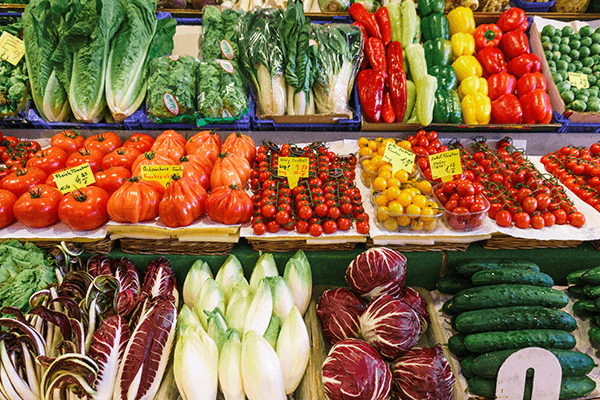Effects of cold storage on Supermarket foods and vegetables | MenuSano
Nowadays, all fruits and vegetables are available in every season in the supermarket due to the invention of cold storage. Not only fruits and vegetables, but perishable foods are also stored in the cold storage to increase their shelf-life and maintain the food quality. But, maintenance of the proper temperature in the cold storage is an essential factor to prevent microbial growth in the food items and protection from food-borne illness. Thousands of Canadian get affected by food poisoning every year due to unsafe food storage. There are multiple symptoms associated with food poisoning, including nausea, vomiting, stomach-ache, diarrhea, persistent fever, headache and constipation. The onset of these symptoms can start immediately after eating the contaminated food items or they can appear after few hours of ingestion. Proper medical care can cure the condition, but it may become dangerous for young children, elderly people and pregnant women. Therefore, there is an emergent need of adequate medical attention to treat this condition immediately after the onset of infection.
Read more: Nutrition Analysis Software for Restaurants
Is Cold storage temperature maintenance essential for food value?
In general, maintaining palatability of food and avoidance of food poisoning are primary objectives for cold storage. However, prevention of food-borne disease is not only the concern, research studies showed that there is a scope of alteration of the phytochemicals present in raw fruits and vegetables during cold storage. These essential phyto-nutrients improves our immunity due to their potent antioxidant property. Following are some evidential reports, which demonstrated the changes of phytochemicals and their activities due to cold storage:
- Researchers reported that the antioxidant activity and total phenolic content in potato are altered due to cold storage.
- Rapisarda et al. submitted study report has been published in a journal article, where it has been mentioned that anthocyanins, flavanones and hydroxycinnamic acids present in oranges and the antioxidant property of oranges are increased by storing at 6°C for 65 days; but the vitamin C content becomes less.
- Researchers also found broccoli stored at 1°C for 28 has a rapid reduction of total antioxidant activity, ascorbic acid and total phenolic compounds contents.
- Certain small fruits like raspberries, strawberries, cherries, sour cherries and red currants stored at 4°C, exhibited mild enhancement of antioxidant activity in comparison with at 25°C.
- Proper cold storage temperature is also essential for blueberries. Blueberries industries are rapidly growing in Canada and other states in the U.S.A. It has been noticed that micro-structural changes occurred due to rapid freezing, which leads to ice crystals formation just beneath the skin of berries and causes sufficient structural damage, including moisture migration, cell shrinkage, and compromised anthocyanin content in the fruit cells. These type of changes is also significant in frozen peas.
- Cold storage temperature can also affect juice content, fruit firmness, weight loss, reduction of pulp content, decrease of soluble nutrients rate, pH, changes in the pigmentation like internal browning, bleaching, skin/peel darkening, changes in texture, increased rates of electrolyte leakage, surface lesions, failure to ripen and other quality parameters.
- In the supermarket, cut fruits and vegetables are also available to make our life easy. These products also requires some storage specifications. The desirable temperature for most of the fresh-cut products is 00 C. But practically, it has been found that during shipment of these types of products, the temperature can vary from 5 to 100 C.
- Not only temperature, duration of cold storage is also an important factor to maintain the food quality. It has been observed that fresh-cut tomatoes stored at 00 C over 14 days, loss their overall quality, enhancement of microbial load, and also declined sensorial quality.
Optimum Refrigeration and Freezing temperature and duration requirement for different perishable food items Canadian Government declared the refrigeration times for safety, and the freezing times for quality of food items. If the food items can properly wrap and store, then it will be helpful to maintain food quality in longer period.
| Food | 400F (40C) or lower temperature in Refrigerator | 00F (-180C) or lower in Freezer |
| Fresh meat | ||
| Ground meat | 1 -2 days | 2- 3 months |
| Veal | 3 -4 days | 8- 12 months |
| Pork | 2 -4 days | 8- 12 months |
| Lamb | 2 -4 days | 8- 12 months |
| Beef | 2 -4 days | 10-12 months |
| Fresh Poultry | ||
| Chicken/Turkey – pieces | 2-3 days | 6 months |
| Chicken/Turkey – whole | 2-3 days | 1 year |
| Fresh fish | ||
| Shrimp, scallops, cooked shellfish | 1-2 days | 2-4 months |
| Shellfish, e.g. crab, clams, lobster etc | 12-24 hours | 2-4 months |
| Fatty fish, e.g. salmon etc. | 3-4 days | 2 months |
| Lean fish, e.g. flounder, cod etc. | 3-4 days | 6 months |
| Ham | ||
| Cooked ham | 3-4 days | 2-3 months |
| Canned ham | 6-9 months | Don’t freeze |
| Bacon and sausages | ||
| Bacon | 1 week | 1 month |
| Pre-cooked sausage links or patties | 1 week | 1-2 months |
| Raw sausage | 1-2 days | 1-2 months |
| Hot dogs | ||
| Opened hotdogs | 1 week | 1-2 months |
| Un-opened hotdogs | 2 weeks | 1-2 months |
| Lunch meat and deli food | ||
| Opened lunch meat | 3-5 days | 1-2 months |
| Un-opened lunch meat | 2 weeks | 1-2 months |
| Deli or homemade salads | 3-5 days | Don’t freeze |
| Deli packaged lunch meat | 3-4 days | 2-3 months |
| Leftovers | ||
| Meat broth and gravy | 3-4 days | 4-6 months |
| Cooked poultry and fish | 3-4 days | 4-6 months |
| Soups | 2-3 days | 4 months |
| Cooked meat, stews, egg or vegetable dishes | 3-4 days | 2-3 months |
| Frozen dinners | ||
| Keep frozen until ready to cook | 3-4 months | |
| Eggs | ||
| Hard-cooked | 1 week | Doesn’t freeze well |
| Fresh out of shell | 2-4 days | 4 months |
| Fresh in shell | 3-4 weeks | Don’t freeze |
| Egg substitutes opened | 3 days | Don’t freeze |
| Egg substitutes un-opened | 10 days | 1 year |
| Dairy products | ||
| Un-opened milk | Best before date | 6 weeks |
| Un-opened cottage cheese | Best before date | Doesn’t freeze well |
| Un-opened yogurt | Best before date | 1-2 months |
| Un-opened unsalted butter | 8 weeks | 3 months |
| Un-opened salted butter | 8 weeks | 1 year |
| Opened milk | 3 days | Don’t freeze |
| Opened yogurt | 3 days | Don’t freeze |
| Opened butter | 3 weeks | Don’t freeze |
| Opened cottage cheese | 3 weeks | Don’t freeze |
| Processed cheese | 5 months | 3 months |
| Hard cheese | 10 months | 1 year |
| Firm cheese | 5 weeks | 3 months |
| Semi-soft cheese | 2-3 weeks | 8 weeks |
| Soft cheese | 1 week | Doesn’t freeze well |
| Vegetables | ||
| Leaf lettuce | 3-7 days | Don’t freeze |
| Iceberg lettuce | 1-2 weeks | Don’t freeze |
| Beans green or waxed | 5 days | 8 months |
| Celery | 2 weeks | 10-12 months |
| Carrots | 2 weeks | 10-12 months |
| Tomatoes | Don’t refrigerate | 2 months |
| Summer squash | 1 week | 10-12 months |
| Winter squash | 2 weeks | 10-12 months |
| Spinach | 2-4 weeks | 10-12 months |
Tips to maintain the optimum food value in cold storage food items
Apart from the staff at the supermarket or cold chain service providers, every individual who purchase, store and prepare foods is equally responsible to maintain food value. Following are some tips to maintain the food value at home and also in food-service industries:
- Purchase frozen or cold products at the end of the shopping.
- Maintain optimum temperature at the refrigerator (40°F) and freezer (0°F) before storing food items to avoid microbial contamination.
- After reaching your destination, all the perishable items, especially raw meat, fish, poultry items and seafood should be stored in refrigerator or in freezer as early as possible.
- Raw meat, fish, poultry, and seafood should be packed properly in the storing container or plastic bags. Then place them on the bottom shelf of the refrigerator to avoid dripping of raw juices onto other foods.
- Separate storage is essential for raw meat, poultry, fish and seafood in the cold storage. Different storing containers can be used for multiple storage.
- All pre-cut fruits and vegetables, ready to eat items, fresh fruits, and vegetables are required to refrigerate immediately after reaching to your destination.
- Select undamaged fruits and vegetables. Carefully observe the color and natural flavor of fruits and vegetables, which indicate the quality of the item.
- Check the expiry date or “best before” date for packed food items.
Read more: Foods to help keep your Kidneys Healthy
Conclusion
Health is wealth, nutritional value of food plays an important our in our well being. MenuSano aims to educate our customers and audience about the importance of nutritious and healthy eating. Our nutrition analysis software is being used by many leading restaurants, hospitals and health conscious individuals. It is economical and delivers exceptional value of your money. We are committed to your well being and better health.



















